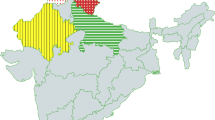Abstract
Mangalore melon (Cucumis melo ssp. agrestis var. acidulus) is a non-dessert melon, extensively grown in the coastal districts of South India, but hardly known to the rest of the World. Immature or mature fruits of Mangalore melon are used in preparation of delicious dishes such as vegetable stew, chutneys and curries. They are appreciated for nutritional values, long shelf life and biotic stress resistance. Seventy-nine accessions of Mangalore melon were collected from five states of South India and their genetic diversity was assessed using inter simple sequence repeat (ISSR) markers. Putative candidate genes of extended shelf life in Mangalore melon were studied by quantitative reverse transcription polymerase chain reaction in comparison with cantaloupe (Cucumis melo L.). Shelf life varied from 65 to 300 days at room temperature. Six ISSR primers amplified 142 fragments ranging from 80 to 2380 bp with an average of 23.66 bands per marker on a high-resolution capillary electrophoresis system. Neighbor joining phylogenetic tree construction from the ISSR allele similarity based genetic distance revealed two major clusters with 46 and 33 accessions in each cluster. Expression of fruit ripening related genes of ethylene biosynthesis (1-aminocyclopropane-1-carboxylate synthase, 1-aminocyclopropane-1-carboxylate oxidase) and cell wall metabolism (polygalacturonase, xyloglucan endotransglucosylase/hydrolase and expansin) in Mangalore melons was significantly lower than the cantaloupe melon at 180 days after harvest. Mangalore melon is a promising genetic resource for enhancing the shelf life of melons. The putative candidate genes identified here are useful in enhancing shelf life of cantaloupe.






Similar content being viewed by others
Data availability
Included as tables. Seeds and raw ISSR genotyping data is available on request.
Code availability
Not applicable.
References
Balachander V (2012) Madras cucumber: finding the origins of this South Indian vegetable Bennett, Coleman & Co. Ltd., Mumbai, India. https://economictimes.indiatimes.com/madras-cucumber-finding-the-origins-of-this-south-indian-vegetable/articleshow/17537078.cms?from=mdr. Accessed 10 July 2020
Barry CS, Giovannoni JJ (2007) Ethylene and fruit ripening. J Plant Growth Regul 26:143–159
Behera TK, Staub JE, Behera S, Delannay IY, Chen JF (2011) Marker-assisted backcross selection in an interspecific Cucumis population broadens the genetic base of cucumber (Cucumis sativus L.). Euphytica 178:261–272
Burger Y, Paris HS, Cohen R, Katzir N, Tadmor Y, Lewinsohn E, Schaffer AA (2010) Genetic Diversity of Cucumis melo. In: Janick J (ed) Horticultural reviews, vol 36. vol 1. Wiley, Hoboken, pp 165–198
Cazzonelli C, Cavallaro A, Botella J (1999) Searching for the role of ethylene in non-climacteric fruits. In: Kanellis AKCC, Klee H, Bleecker AB, Pech JC, Grierson D (eds) Biology and biotechnology of the plant hormone ethylene II. Springer, Dordrecht, pp 29–30
Clarke JD (2009) Cetyltrimethyl ammonium bromide (CTAB) DNA miniprep for plant DNA isolation. Cold Spring Harbor Protocols 2009:pdb. prot5177
Dhillon NP, Monforte AJ, Pitrat M, Sudhakar P, Singh PK, Reitsma KR, Garcia-Mas J, Abhishek S, McCreight JD (2012) Melon landraces of India: contributions and importance. In: Janick J (ed) Plant breeding reviews, vol 35. Wiley-Blacwell, New Jersey, pp 85–150
Endl J, Achigan-Dako EG, Pandey AK, Monforte AJ, Pico B, Schaefer H (2018) Repeated domestication of melon (Cucumis melo) in Africa and Asia and a new close relative from India. Am J Bot 105:1662–1671
Ezura H, Owino WO (2008) Melon, an alternative model plant for elucidating fruit ripening. Plant Sci 175:121–129
Fergany M, Kaur B, Monforte A, Pitrat M, Rys C, Lecoq H, Dhillon N, Dhaliwal S (2011) Variation in melon (Cucumis melo) landraces adapted to the humid tropics of southern India. Genet Resour Crop Evol 58:225–243
Friedman H (2019) Candidate genes to extend fleshy fruit shelf life. In: Goldman I (ed) Plant breeding reviews, vol 43. Wiley-Blackwell, New Jersey, pp 61–94
Giovannoni J (2001) Molecular biology of fruit maturation and ripening. Annu Rev Plant Biol 52:725–749
Gondi S, Ganiger V, Madalageri M, Kotikal Y, UHS B, (2016) Evaluation of oriental pickling melon (Cucumis melo L. var. conomon) genotypes for pest and disease reaction under northern dry zone of Karnataka. J Environ Ecol 7:29–36
Goulao LF, Oliveira CM (2008) Cell wall modifications during fruit ripening: when a fruit is not the fruit. Trends Food Sci Technol 19:4–25
Kamagoud S, Shet RM (2018) Assessment of genetic variability among oriental pickling melon (Cucumis melo var. conomon) genotypes. Int J Curr Microbiol App Sci 6:2630–2633
Koli SP, Murthy HN (2013) Estimation of phenotypic divergence in a collection of Cucumis melo from Kerala State, Southern India. Agric Sci 4:21–31
Kumar S, Stecher G, Li M, Knyaz C, Tamura K (2018) MEGA X: molecular evolutionary genetics analysis across computing platforms. Mol Biol Evol 35:1547–1549
Lakshmi LM, Lingaiah H, Rao AM, Raju T, Pitchaimuthu M, Gowda D (2017a) Variability and genetic divergence studies for economic traits in indigenous oriental pickling melon (Cucumis melo var. conomon) genotypes. Electron J Plant Breed 8:365–370
Lakshmi LM, Lingaiah H, Rao AM, Ramesh S (2017b) AFLP analysis of genetic relationships and diversity of some oriental pickling melon (Cucumis melo var. conomon) genotypes in Karnataka. Int J Agric Sci 13:242–248
Liu K, Muse SV (2005) PowerMarker: an integrated analysis environment for genetic marker analysis. Bioinformatics 21:2128–2129
Livak KJ, Schmittgen TD (2001) Analysis of relative gene expression data using real-time quantitative PCR and the 2−ΔΔCT method. Methods 25:402–408
Manchali S, Kavya K, Sudhakara T (2019) Diversity in Melon (Cucumis melo L.) landraces of Karnataka state of Southern India for downy and powdery mildew disease resistance. Indian J Plant Genetic Resour 32:158–165
Manohar S, Murthy H (2012) Estimation of phenotypic divergence in a collection of Cucumis melo, including shelf-life of fruit. Sci Hortic 148:74–82
Manohar SH, Murthy HN (2011) Use of random amplified polymorphic DNA (RAPD) in differentiation of selected species of Cucumis grown in Southern India. Afr J Biotech 10:9264–9267
Manohar SH, Murthy HN (2014) Fatty acid profile of Cucumis melo var. acidulus (culinary melon) seed oil. J Am Oil Chem Soc 91:815
Miki T, Yamamoto M, Nakagawa H, Ogura N, Mori H, Imaseki H, Sato T (1995) Nucleotide sequence of a cDNA for 1-aminocyclopropane-1-carboxylate synthase from melon fruits. Plant Physiol 107:297–298
Nimmakayala P, Tomason YR, Abburi VL, Alvarado A, Saminathan T, Vajja VG, Salazar G, Panicker GK, Levi A, Wechter WP (2016) Genome-wide differentiation of various melon horticultural groups for use in GWAS for fruit firmness and construction of a high resolution genetic map. Front Plant Sci 7:1437. https://doi.org/10.3389/fpls.2016.01437
Nishiyama K, Guis M, Rose JK, Kubo Y, Bennett KA, Wangjin L, Kato K, Ushijima K, Nakano R, Inaba A (2007) Ethylene regulation of fruit softening and cell wall disassembly in Charentais melon. J Exp Bot 58:1281–1290
Nunez-Palenius HG, Gomez-Lim M, Ochoa-Alejo N, Grumet R, Lester G, Cantliffe DJ (2008) Melon fruits: genetic diversity, physiology, and biotechnology features. Crit Rev Biotechnol 28:13–55
Pawar Y (2018) Madras, Mangalore and a yummy cucumber. DMCL, Bangalore. https://www.dnaindia.com/lifestyle/report-madras-mangalore-and-a-yummy-cucumber-2183187. Accessed 10 July 2020
Peakall R, Smouse P (2006) GENALEX 6: genetic analysis in excel. Population genetic software for teaching and research. Mol Ecol Resour 6:288–295
Pech J-C, Bouzayen M, Latché A (2008) Climacteric fruit ripening: ethylene-dependent and independent regulation of ripening pathways in melon fruit. Plant Sci 175:114–120
Pech JC, Purgatto E, Bouzayen M, Latché A (2012) Ethylene and fruit ripening. In: McManus MT (ed) Annual plant reviews, vol 44. Blackwell Publishing Ltd, New Jersey, pp 275–304
Perpiná G, Cebolla-Cornejo J, Esteras C, Monforte AJ, Picó B (2017) ‘MAK-10’: a long shelf-life charentais breeding line developed by introgression of a genomic region from Makuwa Melon. Hortic Sci 52:1633–1638
Pitrat M, Hanelt P, Hammer K (2000) Some comments on infraspecific classification of cultivars of melon. In: N. Katzir HSP (ed) VII Eucarpia meeting on cucurbit genetics and breeding 510. Acta Horticulture, pp 29–36
Ramesh Babu R, Hariprasad Rao N (2018) Studies on genetic variability, heritability and genetic advance in oriental pickling melon (Cucumis melo L. var. conomon) genotypes. Int J Pure Appl Biosci 6:1042–1047
Rose JK, Bennett AB (1999) Cooperative disassembly of the cellulose–xyloglucan network of plant cell walls: parallels between cell expansion and fruit ripening. Trends Plant Sci 4:176–183
Roy A, Bal S, Fergany M, Kaur S, Singh H, Malik AA, Singh J, Monforte A, Dhillon N (2012) Wild melon diversity in India (Punjab state). Genet Resour Crop Evol 59:755–767
Saladié M, Cañizares J, Phillips MA, Rodriguez-Concepcion M, Larrigaudière C, Gibon Y, Stitt M, Lunn JE, Garcia-mas J (2015) Comparative transcriptional profiling analysis of developing melon (Cucumis melo L.) fruit from climacteric and non-climacteric varieties. BMC Genomics 16:440
Saladié M, Rose JK, Cosgrove DJ, Catalá C (2006) Characterization of a new xyloglucan endotransglucosylase/hydrolase (XTH) from ripening tomato fruit and implications for the diverse modes of enzymic action. Plant J 47:282–295
Sebastian P, Schaefer H, Telford IR, Renner SS (2010) Cucumber (Cucumis sativus) and melon (C. melo) have numerous wild relatives in Asia and Australia, and the sister species of melon is from Australia. Proc Natl Acad Sci 107:14269–14273
Silpa R, George ST, Anitha P, Pradeepkumar T, Vs S, Bastian D, Pathrose B (2019) Genetic divergence analysis in oriental pickling melon (Cucumis melo var. conomon Mak.). Res J Agric Sci 11:115–119
Singh A, Jha A, Dhillon N, Pandey S (2013) Increasing yield and quality of indigenous melons by combining intraspecific group of Cucumis melo. Progress Hortic 45:335–339
Sripongprapai S, Tira-Umphon A (2014) Genetic variation of correlated characters of shelf-life in a cross between Thai melon (Cucumis melo var. conomon) and cantaloupe (Cucumis melo L. var. cantaloupensis). In: Agricultural sciences: leading Thailand to world class standards. Thailand, 4–7 Feb 2014. Kasetsart University, pp 190–199
Srivastava U, Mahajan R, Gangopadhyay K, Singh M, Dhillon B (2001) Minimal descriptors of agri-horticultural crops, part II: vegetable crops, vol II. National Bureau of Plant Genetic Resources, New Delhi
Stepanova AN, Alonso JM (2009) Ethylene signaling and response: where different regulatory modules meet. Curr Opin Plant Biol 12:548–555
Subramanian D (2008) Studies on heterosis expression and association of fruit yield and yield component characters among five intervarietal crosses of Vellari melon (Cucumis melo L.). Madras Agric J 95:24–31
Swamy K (2017) Origin, distribution and systematics of culinary cucumber (Cucumis melo subsp. agrestis var. conomon). J Horticult Sci 12:1–22
Vinutha B, Kotikal Y, Venkateshalu V, Manjunath G, Patil S (2017) Insect-pests composition and natural enemies association on oriental pickling melon, Cucumis melo var. conomon. J Entomol Zool Stud 5:1838–1840
Yamamoto M, Miki T, Ishiki Y, Fujinami K, Yanagisawa Y, Nakagawa H, Ogura N, Hirabayashi T, Sato T (1995) The synthesis of ethylene in melon fruit during the early stage of ripening. Plant Cell Physiol 36:591–596
Acknowledgements
Authors thank Karnataka Science and technology Promotion Society (KSTsPS), formerly Karnataka Biotechnology and Information Technology Services, Govt. of Karnataka, India for funding establishment of Centre for Biotechnology Research, where this research was conducted.
Funding
This research work was supported by Prem Nath Agricultural Science Research Foundation, Bangalore, Karnataka, India.
Author information
Authors and Affiliations
Contributions
RG conceived and designed research, wrote the manuscript. RMS collected, evaluated and maintaining the germplasm. AL and DHR conducted experiments. RCJ Funding acquisition and project administration. All authors read and approved the manuscript.
Corresponding author
Ethics declarations
Conflict of interest
The authors declare that they have no conflict of interest.
Ethical approval
Not applicable.
Consent to participate
Not applicable.
Consent for publication
The Author transfers to Springer the non-exclusive publication rights and he warrants that his/her contribution is original and that he/she has full power to make this grant. The author signs for and accepts responsibility for releasing this material on behalf of any and all co-authors. This transfer of publication rights covers the non-exclusive right to reproduce and distribute the article, including reprints, translations, photographic reproductions, microform, electronic form (offline, online) or any other reproductions of similar nature.
Additional information
Publisher's Note
Springer Nature remains neutral with regard to jurisdictional claims in published maps and institutional affiliations.
Rights and permissions
About this article
Cite this article
Gunnaiah, R., Shet, R.M., Lamani, A. et al. Genetic diversity assessment and gene expression analysis of prolonged shelf-life genes in Mangalore melon (Cucumis melo ssp. agrestis var. acidulus). Euphytica 217, 158 (2021). https://doi.org/10.1007/s10681-021-02887-9
Received:
Accepted:
Published:
DOI: https://doi.org/10.1007/s10681-021-02887-9




